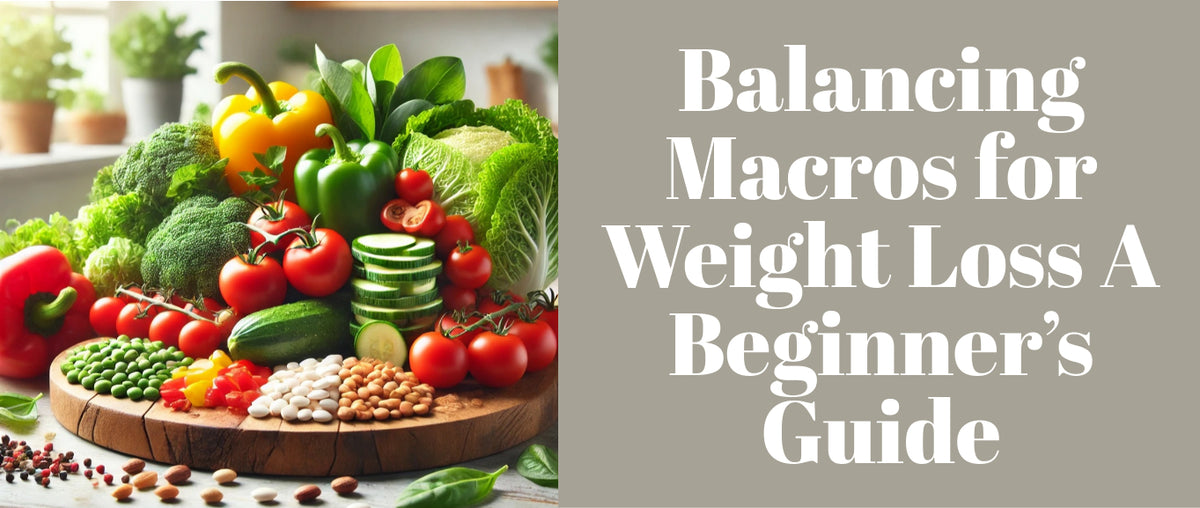Balancing Macros for Weight Loss: A Beginner’s Guide
Achieving weight loss involves more than just cutting calories. It’s about understanding the types of food you consume and how they interact with your body. This is where the concept of balancing macros—short for macronutrients—comes into play. Whether you're aiming to reduce body fat or build muscle, mastering the balance of macros is crucial for a successful healthy diet.
Key Takeaways
- Macronutrients (macros) are proteins, fats, and carbohydrates that provide energy.
- Balancing macros aids in sustainable weight loss by maintaining muscle mass and regulating energy levels.
- Tools like food scales and macro-tracking apps can help you get started.
- Adjusting your macro intake based on your progress is key to continued success.
What Are Macros?
Macros, or macronutrients, are the nutrients that provide calories or energy. There are three primary macronutrients: protein, fats, and carbohydrates. Understanding their roles can help you tailor your diet to meet your specific weight loss goals.
Proteins
Protein is vital for muscle repair and growth, making it especially important when you're losing weight to ensure that you're losing fat, not muscle. High protein intake can also increase your metabolism and help you feel fuller longer.
Foods rich in protein include:
- High Protein Vegan Food such as tofu, tempeh, and lentils.
- High Protein Vegan Breakfast options like scrambled tofu, chia seed pudding, and almond butter smoothies.
- Plant based protein sources like quinoa, chickpeas, and Cashew Butter.
Fats
Despite the bad rap fats have gotten over the years, they are essential for hormone production, nutrient absorption, and overall health. The key is choosing the right types of fats, such as those found in vegan butter , Unsalted Butter, and cashew butter.
Healthy fat sources include:
- Vegan butter alternatives like Garlic Butter made from Plant based oils.
- Heart-healthy diet staples such as unsalted butter and avocados.
- Nuts and seeds, which are also excellent sources of Plant Based Protein.
Carbohydrates
Carbs are the body's primary energy source, especially during physical activity. However, not all carbs are created equal. Complex carbs, such as whole grains, provide sustained energy, while simple carbs, found in sugary snacks, can lead to energy crashes and cravings.
Healthy carb sources include:
- Whole grains like oats, barley, and quinoa.
- Oat Milk, a low-fat alternative to dairy milk, rich in vitamins and minerals.
- Vegetables and fruits, which are also integral to a cholesterol-free foods diet.

Why Balance Macros for Weight Loss?
Balancing your macros is essential for ensuring that your body gets the nutrients it needs to function properly while still allowing you to lose weight. Unlike fad diets that cut out entire food groups, macro balancing promotes a more sustainable and enjoyable approach to eating.
Protein’s Role in Weight Loss
A diet high in protein can prevent muscle loss during weight loss. Muscle is metabolically active, meaning it burns more calories at rest than fat. By maintaining muscle mass, you can keep your metabolism higher, which helps with weight loss.
High Protein Vegan Food options ensure that even those on a Vegan Bodybuilding Diet can meet their protein needs. Including high protein snacks like protein bars made from Plant based protein can also keep you full between meals, reducing the temptation to snack on unhealthy foods.
Fat’s Role in Weight Loss
Healthy fats are crucial for brain health and energy. Incorporating fats like those found in vegan butter and unsalted butter can help you stay satisfied after meals, reducing the likelihood of overeating. Additionally, fats slow down the digestion of carbs, helping to prevent spikes in blood sugar levels, which can lead to fat storage.
Carbohydrates and Energy Regulation
While reducing carb intake can be effective for weight loss, it’s important to include enough carbs to fuel your workouts and daily activities. Eating the right kinds of carbs, such as those found in Oat Milk and whole grains, can provide steady energy and prevent the dips in blood sugar that lead to cravings.
Determining Your Macro Needs
To get started with macro balancing, you'll first need to calculate your daily caloric needs based on your age, sex, weight, height, and activity level. Once you know how many calories you should be consuming, you can divide those calories into the three macronutrients.
Step 1: Calculate Your Caloric Needs
Use an online calculator or consult a nutritionist to determine how many calories you need to maintain your current weight. To lose weight, you'll need to create a calorie deficit, typically by reducing your intake by 500-1000 calories per day.
Step 2: Set Your Macro Ratios
The standard macro ratio for weight loss is:
- 40% carbohydrates
- 30% protein
- 30% fats
This ratio can be adjusted based on your individual needs and preferences. For instance, if you're on a Vegan Bodybuilding Diet, you might increase your protein intake to support muscle growth.
Step 3: Track Your Macros
Start by tracking everything you eat using a food diary or an app. Measure your food to ensure accuracy and use the nutritional information on food labels to calculate the macros for each item.
Getting Started with Macro Counting
Macro counting can seem overwhelming at first, but it becomes second nature with practice. Here’s how to get started:
1. Use the Right Tools
Invest in a food scale to measure your portions accurately. Download an app like MyFitnessPal to log your food and track your macros.
2. Plan Your Meals
Meal planning is essential for staying on track with your macros. Prepare meals in advance, focusing on balanced portions of Plant based protein, healthy fats, and complex carbs. For example, a lunch salad might include unsalted butter roasted vegetables, a serving of vegan cheese, and a portion of quinoa.
3. Be Mindful of Your Choices
When choosing foods, prioritize whole, unprocessed items that are rich in nutrients. Incorporate a variety of Plant based foods like legumes, nuts, seeds, and grains to meet your macro needs.
Adjusting Macros as You Progress
As you progress in your weight loss journey, you may need to adjust your macro ratios. If you hit a plateau or notice a drop in energy levels, it may be time to reevaluate your intake.
Signs You Need to Adjust Your Macros
- Plateau in weight loss: If you stop losing weight, try reducing your carb intake slightly or increasing your protein.
- Low energy: If you feel sluggish, consider increasing your carb intake, especially around your workouts.
- Hunger or cravings: If you're constantly hungry, you might need more fat or protein in your diet.
Common Challenges and How to Overcome Them
Balancing macros can be challenging, especially if you're new to tracking your food intake. Here are some common issues and how to overcome them:
1. Hitting a Weight Loss Plateau
If your weight loss stalls, consider adjusting your macro ratios or increasing your physical activity. Incorporate high protein snacks to keep your metabolism revved up throughout the day.
2. Struggling with Portion Control
Use smaller plates and bowls to help control portion sizes. Focus on eating slowly and savoring your food, which can help you feel full on less.
3. Managing Cravings
Cravings can derail your progress, but you can manage them by ensuring you're eating enough protein and fat. Include high protein snacks and healthy fats in your diet to stay satisfied.
Also Read
Sample Meal Plan
Here’s an example of a day’s worth of meals that balance macros effectively:
Breakfast
- High protein vegan breakfast: Tofu scramble with spinach and garlic butter toast
- Oat Milk smoothie with berries and a scoop of Plant based protein powder
Lunch
- Quinoa salad with roasted vegetables, unsalted butter, and vegan cheese
- Healthy Drinks: Kombucha for digestion
Snack
- Apple slices with cashew butter
- High protein snacks: Hummus with carrot sticks
Dinner
- Stir-fry with tofu, broccoli, and garlic butter sauce over brown rice
- Side of mixed greens with a low fat mayonnaise dressing
Dessert
- Dark chocolate with almond butter
Conclusion
Balancing macros is a sustainable and flexible approach to weight loss that allows you to enjoy a variety of foods while achieving your goals. By understanding your body's needs and making informed food choices, you can create a healthy diet that supports both weight loss and overall well-being.
Do you enjoy vegan food? We have a list of vegan restaurants in India to help you find delicious options in your area!










